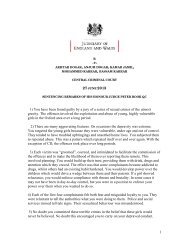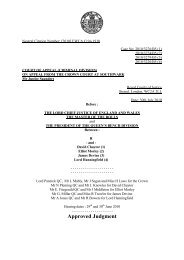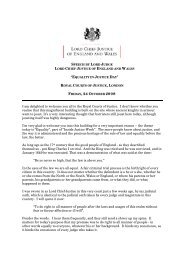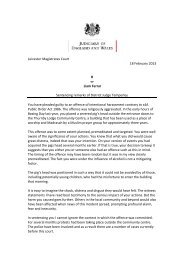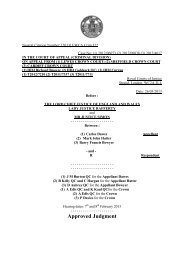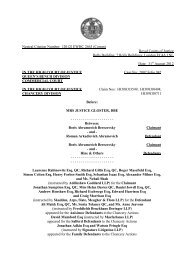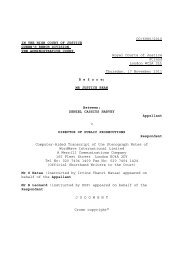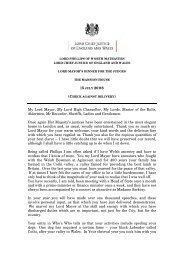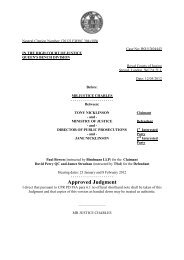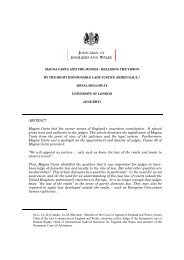Tyrone Laidley and others - sentencing remarks - 7 June ... - Judiciary
Tyrone Laidley and others - sentencing remarks - 7 June ... - Judiciary
Tyrone Laidley and others - sentencing remarks - 7 June ... - Judiciary
You also want an ePaper? Increase the reach of your titles
YUMPU automatically turns print PDFs into web optimized ePapers that Google loves.
R<br />
-V-<br />
TYRONE LAIDLEY AND FIVE OTHERS<br />
SENTENCING REMARKS<br />
H.H. JUDGE WILLIAM DAVIS Q.C.<br />
THE RECORDER OF BIRMINGHAM<br />
In the early days of August 2011 a wave of lawlessness swept through a number of English cities.<br />
I do not need to set out the history of those events. It is summarised in the judgment of the<br />
Lord Chief Justice in R. v Blackshaw <strong>and</strong> <strong>others</strong> [2012] 1 WLR 1126.<br />
So far as Birmingham is concerned disorder began on the evening of the 8 th August. During the<br />
later part of that evening <strong>and</strong> into the early hours of the 9 th August there was looting <strong>and</strong><br />
violence in many parts of the city. This court has dealt with many defendants found guilty of<br />
various offences committed on that night. Severe sentences have been imposed in line with the<br />
guidance given in Blackshaw <strong>and</strong> <strong>others</strong>. I shall reflect that guidance when <strong>sentencing</strong> the<br />
defendants in this case. I note in particular what is said at paragraph 4 of the judgment in<br />
Blackshaw <strong>and</strong> <strong>others</strong>. But no individual case considered by the Court of Appeal in Blackshaw<br />
<strong>and</strong> <strong>others</strong> even begins to approach in seriousness the offences of which these defendants have<br />
been convicted.<br />
At about 11.45 p.m. on the 9 th August 2011 – the second night of disorder in Birmingham – 26<br />
men (all of whom were hooded or masked – or both) made their way along High Street in<br />
Newtown close to the centre of Birmingham. They walked past the Bartons Arms Public<br />
House. They crossed a nearby main road <strong>and</strong> gathered briefly on an area of parkl<strong>and</strong>. In view<br />
of what occurred shortly afterwards, the group plainly was waiting for <strong>others</strong> to arrive. In the<br />
event the group did not wait for those <strong>others</strong>. Within minutes the men had crossed back to the<br />
area close by the Bartons Arms.<br />
The Bartons Arms is a large Victorian building, something of a l<strong>and</strong>mark in Birmingham <strong>and</strong> of<br />
considerable historic significance. It is situated on the main A34 road leading from the centre of<br />
the city towards Walsall. The road is a dual carriageway with a central reservation. The building<br />
1
is located on the carriageway leading into the centre of Birmingham. The opposite carriageway is<br />
raised. The central reservation is substantial with steps opposite the Bartons Arms leading up to<br />
the opposite carriageway. In August 2011 members of staff lived on the second floor of the<br />
premises. On the night of the 9 th August 2011 four staff members – two men <strong>and</strong> two women –<br />
were upstairs getting ready to go to bed. They were able to witness what occurred thereafter,<br />
both from upstairs windows <strong>and</strong> via CCTV cameras within the building.<br />
Once outside the Bartons Arms members of the group attacked the building. They smashed<br />
windows, they went inside <strong>and</strong> they ransacked the premises. They threw chairs <strong>and</strong> tables out<br />
onto the pavement. Other members of the group stayed on the pavement outside the building.<br />
Some threw missiles – bottles <strong>and</strong> the like – at a passing police car. Others lit petrol bombs that<br />
had been brought to the scene. The purpose of all of this was not to loot or to steal. Nor was it<br />
mindless v<strong>and</strong>alism. The purpose – the common purpose – was (a) to behave in such a way that<br />
the police would come to the scene <strong>and</strong> (b) then to attack the police.<br />
The violence continued. Furniture from the public house was strewn across the main road<br />
leading into Birmingham City Centre so as to block the road. Inside the public house petrol<br />
bombs were used to start fires. It was just after these fires had been set that a second group<br />
similarly clad arrived on the scene. They had approached along a side street (Burlington Street).<br />
At one point that group made as if to go down an alleyway to the parkl<strong>and</strong> where the first group<br />
initially had gathered. The second group then diverted so as to go directly to the vicinity of the<br />
Bartons Arms. When the second group arrived, a cheer went up. The arrival of that second<br />
group clearly was expected. The two groups joined together <strong>and</strong> behaved as one group.<br />
This combined group numbered 41 hooded <strong>and</strong>/or masked men. Members of the group<br />
attacked other premises close to the Bartons Arms. As they did so, a police car arrived on the<br />
opposite carriageway. The car stopped <strong>and</strong> police officers got out of the car. The arrival of<br />
those police officers was noticed by two members of the group who alerted the <strong>others</strong>. The<br />
whole group went across to the central reservation <strong>and</strong> up the steps where they looked to where<br />
they believed the police to be. In fact, the officers – seeing the large group – had moved their<br />
car around a corner. However, it was at that point that four police vans containing a large<br />
number of police officers arrived. The group moved back towards the Bartons Arms <strong>and</strong> into<br />
the mouth of Burlington Street. Police officers from the vans moved into position close to the<br />
top of the steps. It was then that several members of the group began to fire shots from<br />
h<strong>and</strong>guns at the police officers st<strong>and</strong>ing on the opposite side of the dual carriageway. At least<br />
four different h<strong>and</strong>guns were fired – a fact that is apparent from the different types of fired<br />
ammunition recovered later. It may well be that more than four guns were used. At least twelve<br />
shots were fired. It is pure good fortune that no police officer was hit by one or more of those<br />
shots. There was gunshot damage to a wall immediately below where the police officers were<br />
st<strong>and</strong>ing. There was gunshot damage to a building behind them indicated that bullets passed just<br />
over their heads. Those who fired the shots were not st<strong>and</strong>ing alone. Many members of the<br />
group remained close to them as they did so.<br />
Almost the entire group then ran off as one. For about 20 to 30 minutes the group made its way<br />
through the Aston area of Birmingham. On occasion the group stopped <strong>and</strong> could be seen (via<br />
CCTV <strong>and</strong> police helicopter footage) to be discussing what to do or where to go next. At one<br />
2
point a member of the group aimed a h<strong>and</strong>gun at the police helicopter <strong>and</strong> fired a shot. Other<br />
members of the group then h<strong>and</strong>ed further ammunition to this individual. The group finally<br />
began to disperse after it had crossed the Aston Expressway. All but three were able to make<br />
their escape. Only six members of the group are to be dealt with by me today. Many <strong>others</strong><br />
escaped. They may never be identified because of the poor quality of the available CCTV<br />
footage <strong>and</strong> because those involved had their faces covered.<br />
These events did not occur spontaneously. They were planned. Firearms were brought to the<br />
scene deliberately as were petrol bombs. When the firearms were used, that was not done<br />
r<strong>and</strong>omly. There was a concerted attack on the police with guns. The evidence does not allow<br />
me to conclude precisely when the plan was hatched <strong>and</strong> when <strong>and</strong> how the detailed<br />
arrangements were made. Some of the defendants were together with <strong>others</strong> late on the evening<br />
of the 7 th August at which point there may have been some preliminary talk as to what might<br />
happen. It is clear that arrangements were well advanced by the afternoon of the 9 th August. It<br />
was then that a group of 20 or more young males were seen in a street in the Aston area <strong>and</strong><br />
heard to be talking about having armed themselves with guns. I am satisfied on the direct<br />
evidence <strong>and</strong> on the inferences to be drawn from the events themselves that all of the<br />
defendants with whom I have to deal went to the scene – whether as part of the first group or<br />
with the second group – knowing that guns were to be carried <strong>and</strong> knowing that they were to be<br />
used assuming the opportunity arose. They were to be used against the police.<br />
All of these defendants are to be sentenced for riot. This was planned violence carried out at a<br />
time of major public disorder <strong>and</strong> with the purpose of luring police officers to the scene so that<br />
they might be attacked. It is a grave offence of its type. Submissions have been made in relation<br />
to the case of Najeeb [2003] 2 Cr.App.R.(S) 69 to the effect that this case is significantly less<br />
serious than that one. In some respects that clearly is correct. What distinguishes this case is the<br />
completely gratuitous nature of the violence.<br />
Moreover, it pales into relative insignificance in comparison to possession of a firearm with<br />
intent to endanger life. Again, all of these defendants are to be sentenced for that offence. Any<br />
offence involving loaded firearms will be dealt with severely. In Avis [1998] 1 Cr.App.R. 420<br />
Lord Bingham said that, where there is an offence contrary to a relevant section of the Firearms<br />
Act 1968, any sentence of imprisonment would be of considerable length with the length of<br />
sentence being determined by the answers to four questions:<br />
What sort of weapon was involved?<br />
What use was made of the firearm?<br />
With what intention was the firearm possessed?<br />
What is the record of the defendant?<br />
In Sheen <strong>and</strong> Sheen [2011] EWCA Crim 2461 Lord Justice Stanley Burnton identified two<br />
further questions:<br />
3<br />
Where was the firearm discharged <strong>and</strong> who was exposed to danger by its use?<br />
Was any injury caused by the firearm <strong>and</strong>, if so, how serious was it?
In this case the weapons involved were loaded h<strong>and</strong>guns which could have had no legitimate<br />
lawful use. They were used to attack police officers on the ground <strong>and</strong> in a police helicopter.<br />
The intention was to endanger life. Although no physical injury was suffered, that was wholly a<br />
matter of luck. Had the police helicopter been struck, the consequences could have been<br />
catastrophic. There may have been no physical injury to a police officer. The damage to the<br />
well-being of the city of Birmingham caused by an armed gang prepared to act in this way was<br />
grave. In addition to the aggravating features identified by Lord Bingham <strong>and</strong> Lord Justice<br />
Stanley Burnton, this case is aggravated by the fact that the use of the firearms occurred as part<br />
of planned gang violence against the police against the background of substantial <strong>and</strong> continuing<br />
public disorder. It is very difficult to conceive a case of this type more serious than this one.<br />
In Sheen <strong>and</strong> Sheen it was argued by the appellants that the offence of possessing a firearm with<br />
intent to endanger life is necessarily less serious than the offence of attempted murder. The<br />
Court of Appeal rejected that argument. It concluded that an offence under Section 16 of the<br />
Firearms Act 1968 “may, in appropriate circumstances, require a custodial sentence that is as<br />
long as, or may even be longer, than a sentence for attempted murder”. This is such a case.<br />
Multiple gun shots were fired at police officers doing their duty at a time of widespread public<br />
disorder by members of a gang carrying out a deliberate plan to attack the police. Had any police<br />
officer been struck by a bullet <strong>and</strong> had the charge been one of attempted murder, proper<br />
application of the definitive guideline would have led to a sentence of at least 30 years<br />
imprisonment. That is the starting point in this case for any defendant who used a gun will be<br />
less than that but not substantially less.<br />
For all but one of these defendants the position is aggravated by the fact that they were party to<br />
arson of the Bartons Arms in circumstances which put the lives of those within the public house<br />
at risk. The defendants were completely indifferent to the welfare of those upstairs. All they<br />
were interested in was luring the police to the area. The fact that the members of staff looking<br />
on helplessly upstairs were put in real fear <strong>and</strong> no little danger meant nothing to them.<br />
These general considerations apply to all of the defendants. The individual sentences will vary<br />
according to whether the defendant himself used a gun <strong>and</strong> with the age <strong>and</strong> record of the<br />
defendant. Use of a gun by a defendant will attract a very long sentence. The fact that a<br />
defendant did not himself use a gun will reduce the sentence. Even in the case of such a<br />
defendant, the fact that the offence occurred in the context of planned group violence <strong>and</strong> was<br />
encouraged by him means that a substantial custodial sentence is required.<br />
In each case I have considered the issue of dangerousness. I am satisfied that more than one of<br />
these defendants falls within the definition of dangerousness as set out in Section 224 of the<br />
Criminal Justice Act 2003. The length of the determinative sentences that I shall impose is such<br />
that in each case the public will be protected sufficiently without the imposition of a life sentence<br />
or an indeterminate sentence.<br />
4
In each case the defendant will be given full credit for the number of days spent on rem<strong>and</strong><br />
pending sentence. If the days identified today by the prison authorities proves to be incorrect,<br />
credit will be given for the correct number of days without the need for any further hearing.<br />
I shall pass concurrent sentences in each case. The aggravating factors indicated by the offences<br />
of riot <strong>and</strong> arson will be reflected in the sentence for the firearms offence.<br />
None of the defendants can claim credit for a plea of guilty. Each of them was convicted after a<br />
trial.<br />
<strong>Tyrone</strong> <strong>Laidley</strong><br />
You were one of those present when a group met on the evening of the 7 th August 2011. I<br />
conclude that you were involved from the outset in the planning of these offences. You were<br />
part of the first group <strong>and</strong> you were directly involved in the attacks on the Bartons Arms <strong>and</strong> on<br />
other premises. You were armed with a h<strong>and</strong>gun. I cannot say whether you used it when the<br />
shots were fired from Burlington Street. You did fire a shot at the police helicopter. Had the<br />
shot hit the helicopter, the consequences potentially would have been catastrophic.<br />
You were 19 at the time of the events <strong>and</strong> you are only 20 now. You have only a limited<br />
previous record (though it is to be noted you were on bail at the time of these events for an<br />
offence later dealt with by the magistrates). These are the only matters which can mitigate your<br />
sentence which will be as follows:<br />
Count 3 (possession of a firearm with intent to endanger life)<br />
23 years’ detention in a young offender institution<br />
Count 1 (riot)<br />
7 years’ detention in a young offender institution<br />
Count 4 (arson being reckless as to endangering life)<br />
7 years’ detention in a young offender institution<br />
Wayne Collins<br />
You live in Luton. You came to Birmingham on the afternoon of the 7 th August. Whatever<br />
your initial reason for coming to Birmingham, you were present at the meeting late on the<br />
evening of that day. You then spent your time with Jermaine Lewis <strong>and</strong> (latterly) Nicholas<br />
Francis. The purpose of your continued presence in Birmingham was to take part in the attack<br />
on the police which eventually occurred on the 9 th August. It is significant that Francis was one<br />
of those carrying a gun. You must have known that <strong>and</strong>, with that knowledge, went with him.<br />
Although you played no active role in events at the Bartons Arms, your presence there as part of<br />
the first group encouraged <strong>others</strong> <strong>and</strong>, in particular, encouraged those armed with guns to use<br />
them.<br />
You are 25 so you cannot use age as a mitigating feature. But you have only a very limited<br />
criminal history which can mitigate the sentence. I take account also of the fact that hitherto you<br />
5
have been a working man with a family. Taking into account the nature of your involvement in<br />
these offences, the sentences will be as follows:<br />
Count 3<br />
18 years’ imprisonment<br />
Count 1<br />
6 years’ imprisonment<br />
Count 4<br />
6 years’ imprisonment<br />
Renardo Farrell<br />
You were part of the first group. You went into the Bartons Arms. I cannot be sure whether<br />
you were directly involved in setting a fire within the premises because the CCTV cameras did<br />
not cover the relevant area. However, you were very close by when firebombs were set off <strong>and</strong><br />
you were closely involved with that part of the plan. That is a particular aggravating feature in<br />
your case. You also were directly involved in the attack on other premises prior to the arrival of<br />
the police. I cannot find that you carried a gun but, as the jury have found, you intended to<br />
encourage those who did have guns. Given your involvement from the outset, I am satisfied<br />
that you knew of the potential use of guns from the outset.<br />
You are now 20 <strong>and</strong> you have no real criminal history. Your sentences will be as follows:<br />
Count 3<br />
18 years’ detention in a young offender institution<br />
Count 1<br />
6 years’ detention in a young offender institution<br />
Count 4<br />
7 years’ detention in a young offender institution<br />
Amirul Rahman<br />
You arrived with the second group. Indeed, you were at the front of that group. Once there<br />
you joined in with the attack on premises close to the Bartons Arms. You remained with the<br />
group when shots were being fired in Burlington Street. You were close to a man who was<br />
reloading a h<strong>and</strong>gun whilst <strong>others</strong> were firing. You encouraged <strong>and</strong> intended to encourage the<br />
use of firearms. I am satisfied that most of those in the second group came to the scene to join<br />
the common purpose <strong>and</strong> with the knowledge of the potential use of firearms. You were one of<br />
those. I reject the proposition that you only became aware of the presence of guns at some later<br />
point.<br />
6
You are only 17. You were only 16 at the time of the events. Essentially you are of good<br />
character. The jury heard that you were associated with a group who had pretensions to be part<br />
of gang culture. The only relevance of that is to explain how someone such as you became<br />
involved in the events of this night.<br />
Your age means that, for any offence not punishable with a sentence of 14 years or longer, the<br />
maximum sentence available is a period of 24 months detention <strong>and</strong> training. Were I dealing<br />
with you only for the offence of riot, that would be the maximum sentence. But I am to<br />
sentence you for your complicity in the possession <strong>and</strong> use of firearms where the maximum<br />
sentence is life. Therefore, I have to decide whether a detention <strong>and</strong> training order is suitable to<br />
meet the justice of your case. I am satisfied that it is not. It is necessary for you to be detained<br />
for considerably longer that the maximum period allowed under a detention <strong>and</strong> training order.<br />
I shall pass a sentence of detention under Section 91 of the Powers of Criminal Courts<br />
(Sentencing) Act 2000 in respect of Count 3. That sentence will take into account your<br />
involvement in the offence of riot. No separate penalty will be imposed in relation to that<br />
offence.<br />
Your age does mean that, in accordance with the relevant SGC guideline, the sentence must be<br />
less than for an equivalent adult offender. In your case it will be two thirds of that which would<br />
have been passed had you been an adult.<br />
Count 3<br />
12 years’ detention under Section 91<br />
No separate penalty on Count 1<br />
Nicholas Francis<br />
You were part of the first group. You played a full <strong>and</strong> active part in the initial violence. You<br />
had a gun. I am satisfied of that given what is apparent on the CCTV footage <strong>and</strong> given that<br />
there was a photograph on your mobile telephone of a .25 semi automatic h<strong>and</strong>gun. Just such a<br />
h<strong>and</strong>gun was used to fire shots at the police officers from the area of Burlington Street. I<br />
conclude that you were one of those firing such a gun.<br />
You are 25. You have a bad record. In 2005 you were sentenced to 5 years’ detention for<br />
offences of robbery. You are an active member of a street gang in West Bromwich – the Raiders<br />
– which has used firearms in the past <strong>and</strong> which is associated with the Johnson Crew – a<br />
notorious Birmingham street gang. The video material adduced as evidence during the case<br />
demonstrates that you enjoy the notion of h<strong>and</strong>ling <strong>and</strong> using firearms <strong>and</strong> that you have a deep<br />
antipathy towards the police. You are most clearly a dangerous man <strong>and</strong> you come close to<br />
requiring a life sentence. I avoid such a sentence only because of the length of the determinate<br />
sentence that is appropriate in your case.<br />
7
Count 3<br />
30 years’ imprisonment<br />
Count 1<br />
7 years’ imprisonment<br />
Count 4<br />
7 years’ imprisonment<br />
Jermaine Lewis<br />
I am satisfied on the evidence that you spent the 9 th August in the company of Francis <strong>and</strong><br />
Collins <strong>and</strong> that you drove them to the area of the Bartons Arms in the later part of that evening.<br />
You knew full well that you were taking an armed man to that area <strong>and</strong> that guns were to be used<br />
to fire on the police. You made your escape from the Aston area with Francis. In order to do<br />
so you <strong>and</strong> he (<strong>and</strong> <strong>others</strong>) by force took a car from an innocent man in the street. Although I<br />
cannot find on the evidence that you were armed yourself, you were the means by which an<br />
armed man got to the scene <strong>and</strong> you escaped with him.<br />
You are 27. You have no significant criminal history. However, like Francis, you are an active<br />
member of a street gang in West Bromwich – the Raiders – which has used firearms in the past<br />
<strong>and</strong> which is associated with the Johnson Crew – a notorious Birmingham street gang. The<br />
video material <strong>and</strong> material from your mobile telephone adduced as evidence during the case<br />
demonstrates your attitude to guns <strong>and</strong> to the police.<br />
Count 3<br />
23 years’ imprisonment<br />
Count 1<br />
7 years’ imprisonment<br />
Count 4<br />
7 years’ imprisonment<br />
8





